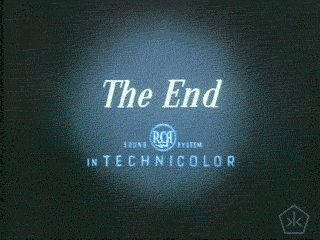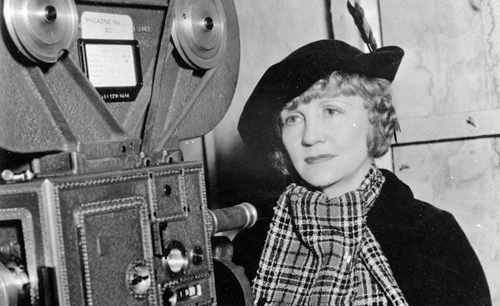Natalie Kalmus was born in 1882 and has 404 credits on IMDB.
Just to give you an idea how incredible that is, Steven Spielberg has 299 IMDB credits, Alfred Hitchcock clocks in at 204 and James Cameron, 151 (come on James, get it together).
So who was Natalie Kalmus and how did this woman, born before the Hollywood boom even existed, rack up such an impressive cinematic CV?
Well, Natalie Kalmus gave us colour film.
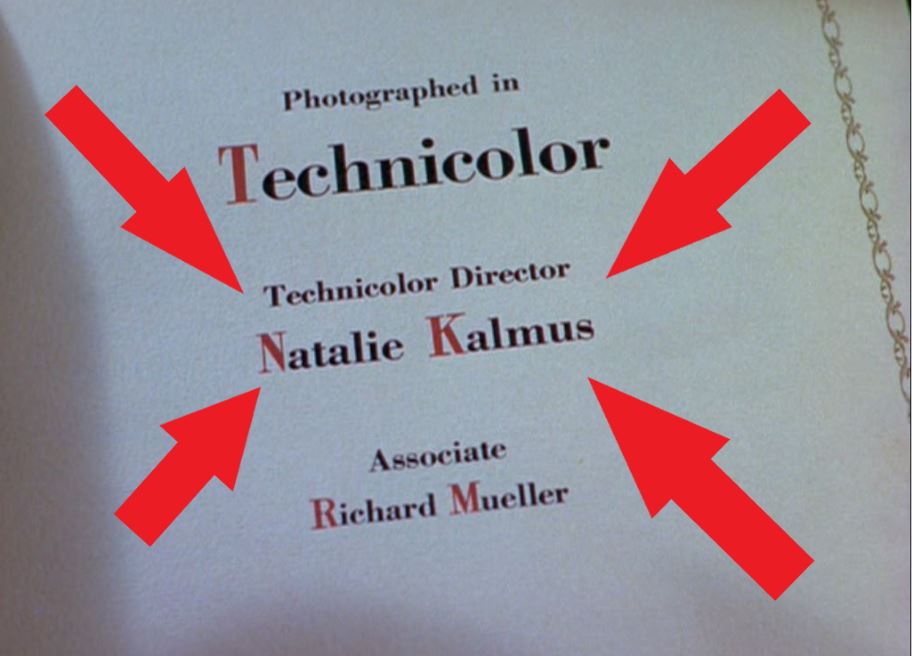
The creation of colour film
Natalie was married to Herbert Kalmus, who was the founder and president of Technicolor. A graduate of MIT, Herbert founded the company with several of his friends in 1914.
Now, Technicolor was far from the first colour film technology maker. From 1909, British born company, Kinemacolor was the market leader, offering Hollywood tech for creating colour film.
Their system transformed black and white film by projecting it through alternating between red and green filters.
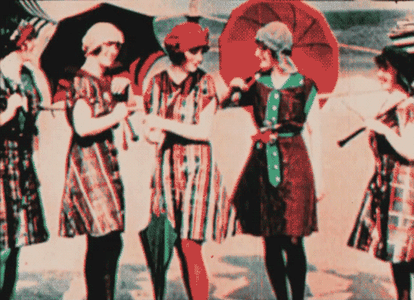
As you can see, there is colour, but it’s far from true to life.
Though there was scope for Kinemacolor to evolve, it was never going to move much past the heavy red and green hues.
So Herbert Kalmus and his pals at Technicolor ditched the green red method and spent the next 2 DECADES trying to come up with a better way to make colour film.
Sadly, everything Herbert tried was either ridiculously expensive, needed a ton of experienced people to operate or just didn’t create the desired effect.
But by 1932 Herbert had the system perfected! Essentially this new system worked from start to finish; from using refracted light in the camera to bathing the film strip in coloured dye (this is a really basic description, click here for more detail)
Finally, colour film was a go! Sadly… nobody wanted it.
The Great Depression had just hit and no one wanted to take a punt on Technicolor and its expensive services. This was not an economy in which to take a gamble!
That is, unless you were Walt Disney…
In 1932 Herbert Kalmus convinced Walt Disney to try out his new tech. Disney agreed, with the caveat he had total animation monopoly on Technicolor until 1935 (classic Disney business move: smart and oh so scary)
Disney’s Silly Symphonies, Flowers and Trees short, was the first animation by the studio to use Technicolor.
Released in 1933, it was an immediate hit with audiences and critics alike.
The worth of Technicolor had been proved and soon enough all the major studios were desperate to make the move to colour.
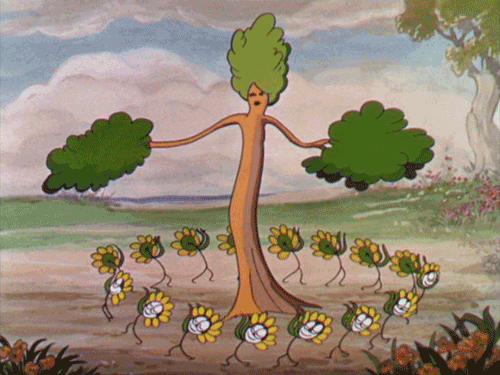
The race to make the next hit colour picture sounded one hell of a pay day for Technicolor.
You see, studios couldn’t buy Technicolor equipment outright, they had to rent everything. This massively boosted the companies bottom line.
BUT there was one huge issue:
Quality control
The possibilities of what could be achieved with this level of colour were endless and as such, film makers were chomping at the bit to get to play with this new tech.
They wanted to use all the crayons in the box, at the same time. As anyone who has ever seen a child’s drawing can attest – that is not always a good thing.
But one person stood between directors and the future of film looking like a toddlers psychedelic nightmare doodle.
That person, was Natalie Kalmus.
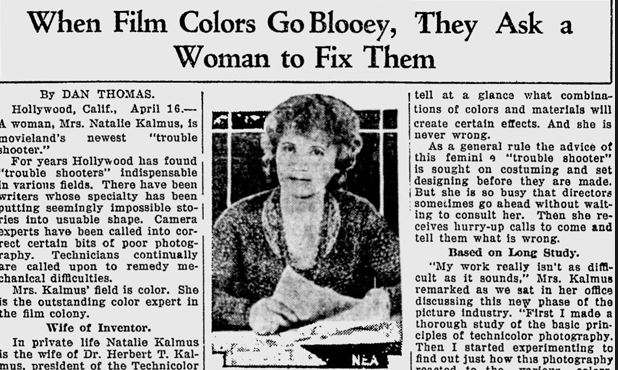
Natalie wanted to ensure that Technicolor lasted as both a company and an industry standard. She believed that colour had the potential to be more than a money grabbing fad. It could totally revolutionise film as an art form.
But that couldn’t happen if film makers were able to just throw the entire kitchen sink at the screen!
So when you hired Technicolor equipment, you also had to hire Natalie Kalmus.
Natalie served as colour supervisor on almost every Technicolor film from 1934 – 1949.
A former art student and passionate art lover, Natalie was the perfect person to steer the future of colour film. Although Herbert Kalmus and Natalie had secretly split by 1922 (though they continued living together) she’d been right there during Technicolor’s decades long inception, often serving as it’s on screen test model.
There was nobody who understood the tech and its artistic capabilities better.

In 1935, Natalie wrote her magnum opus: ‘Colour Consciousness’
Rather than just throwing everything at the screen, Natalie wanted colour to be carefully orchestrated through the film. In the same way that a films score underpins the story, emotions and individual characters, so would colour.
Through Colour Consciousness, Natalie asked the filmmakers working with Technicolor to delve through art history, looking at how these painters used colours to tell their stories.
By doing this, Natalie was hammering home the importance of people’s psychological reaction to specific hues, as well as how good they’d look on screen.
As an example, lets take The
Wizard of Oz. In the film, Dorothy’s shoes aren’t just changed from their original silver, because red will look better!
Yes they pop on that yellow brick road, but they also contrast as the polar opposite to the Wicked Witches uncanny and sinister looking green skin.
The ruby slippers are that particular shade of ruby red because it’s one that creates a feeling of lively fun, rather than just a few shades darker, which can conjure thoughts of blood!
That’s a lot of thought on what’s essentially a prop. But it clearly worked, because decades later, those shoes are still world famous!
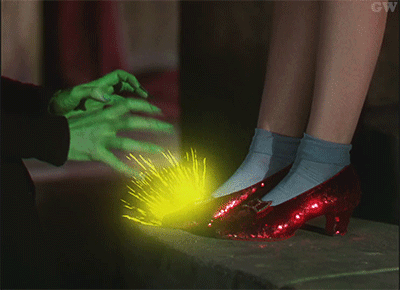
Natalie didn’t just boost a stories plot through colour, she also made the whole film a visual feast.
As we have covered, Technicolor was a totally new visual tech and black and white methods for camera, art design, lighting, costuming, and well, everything else would not work here!
There was a lot of scope to get things wrong! Seriously, if colour film isn’t done right it has the capability to make some people actually feel physically ill (kind of like how 3D films did a couple of years ago…)
NOT ON NATALIE’S WATCH!
So once more Natalie looked to art for inspiration and taught entire crews how to change their work to match this new tech.
She showed Art Departments how mix of warm and dark tones to make previously flat sets look deep. Lighting crews how ow to use shadow and coloured lighting together. And schooled directors in working within in a specific palette to create a colour scheme that didn’t detract but rather worked harmoniously to tell the story.
This is why the advent of colour films gives us these gloriously detailed sets. Sumptuous costuming and the first use of colour coding to set a character or mood.
If this sounds like big deal, it’s because it is. All of this is a HUGE part of the foundation for film making as we know it today.

BUT not all of Hollywood’s power players were down with Natalie and her new techniques.
Much of this was due to the old boys club not loving the fact that a woman was coming onto their set and having a say.
Add to that the fact that Natalie had no problem entering a shouting match with Hollywood’s leading male directors, and you have a powder keg just waiting to explode.
Thus, Natalie was loathed by the vast majority of the filmmakers she worked with.
David O Selznick was so riled up by Natalie that he actually tried to have Gone With The Wind shot in black and white, just to get her off his set!
Another film maker, Allan Dwan later summed up his opinion on Natalie:
‘Natalie Kalmus is a bitch’
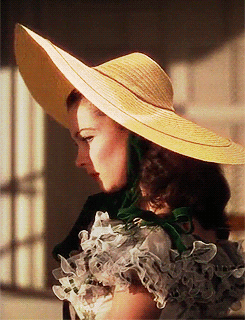
But, did all this hate deter Natalie?
Nope!
Instead of shying away, she built up a huge department of colour supervising specialists and led the charge of colour film-making.
Natalie had a direct hand in almost every colour film made for over a decade. THAT’S HUNDREDS AND HUNDREDS OF FILMS!
It’s very much because of Natalie, her techniques and her work that Technicolor was a success. It didn’t die out as a fad, but proved colour was key to making films. Not only bringing in crowds but becoming a vital tool in making GREAT cinema.
This meant that studios were happy to continue paying more money to make colour pictures over black and white, during economic low periods like WW2.
Thus, Natalie Kalmus is arguably the reason that colour cinema sustained.

So then, if Natalie Kalmus is so great then why did she stop working and why haven’t we heard of her?
Well for 2 reasons:
-
The old boys club finally won
By the late 1940s, Natalie had pissed too many of Hollywood’s powerful men. She started to be removed from sets, gradually working less and less as rumours of her ‘hysterical’ outbursts spread.
This was exasperated by:
2. Her alimony case against Herbert Kalmus
Though Natalie and Herbert split in the early 1920s, their breakup was pretty amicable, they even continued living together! All was well, until the 1940s, when Herbert decided to remarry. Essentially kicking Natalie out.
So she went to court in pursuit of alimony.
After all, Herbert was a very rich man and much of that wealth was thanks to Natalie. She wanted what was hers.
Sadly the courts didn’t agree and Natalie’s case was thrown out of court. Upon the news, she broke down, begging the judge for ‘justice’.
As she sobbed, photographers snapped away and soon enough this was all over town:
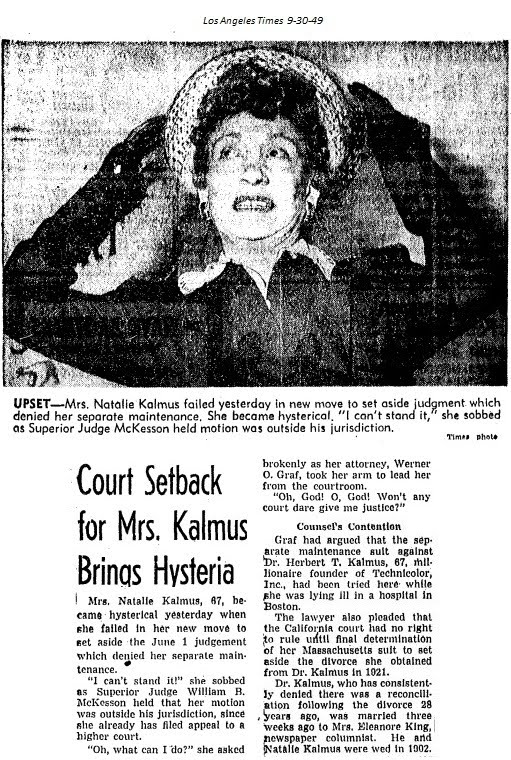
After the fallout of the trial and the ongoing rumours of her ‘hysterical’ nature, Herbert stripped Natalie of her job at Technicolor.
Natalie never recovered from this career blow and she didn’t work in film again.
She died quietly in 1965, mostly forgotten by the industry she helped build.
But Natalie’s film legacy lives on. Her work is the building blocks for modern Hollywood. So next time you watch a colour film, be it Singing In The Rain, Gone with Wind, The Red Shoes, or the latest blockbuster, thank Natalie Kalmus.
This was interesting, where can I find out more? Well, there’s nobody better than the woman herself to show you how enduring Natalie Kalmus work is. So I suggest you check it her amazing, Colour Consciousness, which you can do, for free, HERE.
